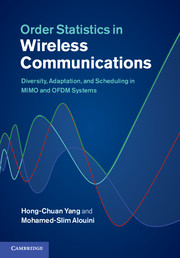 Order Statistics in Wireless Communications
Order Statistics in Wireless Communications Published online by Cambridge University Press: 07 October 2011
Introduction
We present a brief summary of digital wireless communications in this chapter. The material will serve as a useful background for the advanced wireless technologies in later chapters. We first review the statistical fading channel models commonly used in wireless system analysis. After that, we discuss digital modulation schemes and their performance analysis over fading channels, including the well-known moment generating function (MGF)-based approach [1]. The basic concept of adaptive modulation and diversity combining will also be presented. While most of the materials of this chapter are reviews of classical results, which can be found in other wireless textbooks, this chapter provides for the first time a thorough treatment of various conventional threshold-based combining schemes, a class of combining scheme enjoying even lower complexity than selection combining (SC). The chapter concludes with a brief discussion of the transmit diversity technique. The discussion of this chapter is by no means comprehensive. The main objective is to introduce some common notation and system models for later chapters. For a thorough treatment of these subjects, the reader may refer to [1,2].
Statistical fading channel models
Wireless channels rely on the physical phenomenon of electromagnetic wave propagation, due to the pioneering discoveries of Maxwell and Hertz. Radio waves propagate through several mechanisms, including direct line of sight (LOS), reflection, diffiraction, scattering, etc. As such, there usually exist multiple propagation paths between the transmitters and the receivers, as illustrated in Fig. 2.1.
To save this book to your Kindle, first ensure no-reply@cambridge.org is added to your Approved Personal Document E-mail List under your Personal Document Settings on the Manage Your Content and Devices page of your Amazon account. Then enter the ‘name’ part of your Kindle email address below. Find out more about saving to your Kindle.
Note you can select to save to either the @free.kindle.com or @kindle.com variations. ‘@free.kindle.com’ emails are free but can only be saved to your device when it is connected to wi-fi. ‘@kindle.com’ emails can be delivered even when you are not connected to wi-fi, but note that service fees apply.
Find out more about the Kindle Personal Document Service.
To save content items to your account, please confirm that you agree to abide by our usage policies. If this is the first time you use this feature, you will be asked to authorise Cambridge Core to connect with your account. Find out more about saving content to Dropbox.
To save content items to your account, please confirm that you agree to abide by our usage policies. If this is the first time you use this feature, you will be asked to authorise Cambridge Core to connect with your account. Find out more about saving content to Google Drive.